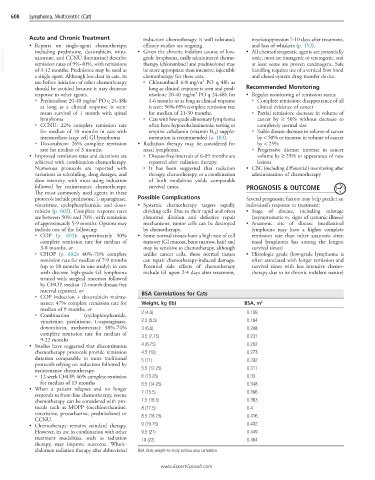Page 1219 - Cote clinical veterinary advisor dogs and cats 4th
P. 1219
608 Lymphoma, Multicentric (Cat)
Acute and Chronic Treatment induction chemotherapy is well tolerated; myelosuppression 7-10 days after treatment,
efficacy studies are ongoing.
and loss of whiskers (p. 152).
• Reports on single-agent chemotherapy, • Given the chronic indolent course of low- • All chemotherapeutic agents are potentially
VetBooks.ir xantrone, and CCNU (lomustine) describe grade lymphoma, orally administered chemo- toxic, most are mutagenic or teratogenic, and
including prednisone, doxorubicin, mito-
remission rates of 9%-40%, with remissions
at least some are proven carcinogens. Safe
therapy (chlorambucil and prednisolone) may
of 3-12 months. Prednisone may be used as
chemotherapy for these cats.
and closed-system drug transfer device.
a single agent. Although less clear in cats, its be more appropriate than intensive, injectable handling requires use of a vertical flow hood
2
use before initiation of other chemotherapy ○ Chlorambucil 6-8 mg/m PO q 48h as
should be avoided because it may decrease long as clinical response is seen and pred- Recommended Monitoring
2
response to other agents. nisolone 20-40 mg/m PO q 24-48h for • Regular monitoring of remission status
2
○ Prednisolone 20-40 mg/m PO q 24-48h 4-6 months or as long as clinical response ○ Complete remission: disappearance of all
as long as a clinical response is seen: is seen: 56%-69% complete remission rate clinical evidence of cancer
mean survival of 1 month with spinal for median of 21-30 months. ○ Partial remission: decrease in volume of
lymphoma ○ Cats with low-grade alimentary lymphoma cancer by ≥ 50% without decrease to
○ CCNU: 22% complete remission rate often have hypocobalaminemia; testing or completely normal size
for median of 10 months in cats with empiric cobalamin (vitamin B 12 ) supple- ○ Stable disease: decrease in volume of cancer
intermediate-large cell GI lymphoma mentation is recommended (p. 183). by < 50% or increase in volume of cancer
○ Doxorubicin: 26% complete remission • Radiation therapy may be considered for by < 25%
rate for median of 3 months nasal lymphoma. ○ Progressive disease: increase in cancer
• Improved remission rates and durations are ○ Disease-free intervals of 6-69 months are volume by ≥ 25% or appearance of new
achieved with combination chemotherapy. reported after radiation therapy. lesions
Numerous protocols are reported with ○ It has been suggested that radiation • CBC (including differential) monitoring after
variations in scheduling, drug dosages, and therapy, chemotherapy, or a combination administration of chemotherapy
dose intensity, with most using induction of both modalities yields comparable
followed by maintenance chemotherapy. survival times. PROGNOSIS & OUTCOME
The most commonly used agents in these
protocols include prednisone, L-asparaginase, Possible Complications Several prognostic factors may help predict an
vincristine, cyclophosphamide, and doxo- • Systemic chemotherapy targets rapidly individual’s response to treatment:
rubicin (p. 602). Complete response rates dividing cells. Due to their rapid and often • Stage of disease, including substage
are between 50% and 70%, with remission abnormal division and defective repair (asymptomatic vs. signs of systemic illness)
of approximately 5-9 months. Options may mechanisms, tumor cells can be destroyed • Anatomic site of disease (mediastinal
include one of the following: by chemotherapy. lymphoma may have a higher complete
○ COP (p. 602): approximately 50% • Some normal tissues have a high rate of cell remission rate than other anatomic sites;
complete remission rate for median of turnover (GI mucosa, bone marrow, hair) and nasal lymphoma has among the longest
3-8 months, or may be sensitive to chemotherapy, although survival times)
○ CHOP (p. 602): 40%-70% complete unlike cancer cells, these normal tissues • Histologic grade (low-grade lymphoma is
remission rate for median of 7-9 months can repair chemotherapy-induced damage. often associated with longer remission and
(up to 18 months in one study); in cats Potential side effects of chemotherapy survival times with less intensive chemo-
with discrete high-grade GI lymphoma include GI upset 2-4 days after treatment, therapy due to its chronic indolent nature)
treated with surgical resection followed
by CHOP, median 12-month disease-free
interval reported, or BSA Correlations for Cats
○ COP induction + doxorubicin mainte-
nance: 47% complete remission rate for Weight, kg (lb) BSA, m 2
median of 9 months, or
○ Combination (cyclophosphamide, 2 (4.5) 0.159
vincristine, prednisone, L-asparaginase, 2.5 (5.5) 0.184
doxorubicin, methotrexate): 38%-74% 3 (6.5) 0.208
complete remission rate for median of 3.5 (7.75) 0.231
9-22 months
• Studies have suggested that discontinuous 4 (8.75) 0.252
chemotherapy protocols provide remission 4.5 (10) 0.273
duration comparable to more traditional 5 (11) 0.292
protocols relying on induction followed by
maintenance chemotherapy. 5.5 (12.25) 0.311
○ 12-week CHOP: 46% complete remission 6 (13.25) 0.33
for median of 13 months 6.5 (14.25) 0.348
• When a patient relapses and no longer
responds to front-line chemotherapy, rescue 7 (15.5) 0.366
chemotherapy can be considered with pro- 7.5 (16.5) 0.383
tocols such as MOPP (mechlorethamine, 8 (17.5) 0.4
vincristine, procarbazine, prednisolone) or 8.5 (18.75) 0.416
CCNU.
• Chemotherapy remains standard therapy. 9 (19.75) 0.432
However, its use in combination with other 9.5 (21) 0.449
treatment modalities, such as radiation 10 (22) 0.464
therapy, may improve outcome. Whole-
abdomen radiation therapy after abbreviated BSA, Body weight–to–body surface area correlation.
www.ExpertConsult.com

